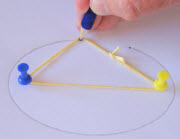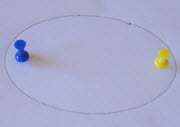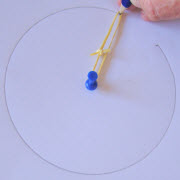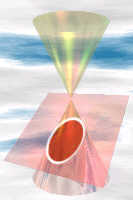Semi Major Axis Of Ellipse
Ellipse
An ellipse usually looks like a squashed circle:
images/geom-ellipse.js?mode=foci
"F" is a focus, "G" is a focus,
and together they are called foci.
(pronounced "fo-sigh")

The total distance from F to P to Thousand stays the same
In other words, we always travel the same distance when going from:
- point "F" to
- to whatsoever point on the ellipse
- and and so on to point "Chiliad"
You Tin can Depict It Yourself
Put two pins in a board, and then ...

put a loop of cord around them,

insert a pencil into the loop,

stretch the string so it forms a triangle,

and depict a curve.
It is an ellipse!
Information technology works considering the string naturally forces the same altitude from pin-to-pencil-to-other-pin.
A Circumvolve is an Ellipse

In fact a Circle is an Ellipse, where both foci are at the aforementioned point (the center). Then to draw a circle we only need one pin!

A circumvolve is a "special case" of an ellipse. Ellipses Rule!
Definition
An ellipse is the ready of all points on a plane whose distance from two fixed points F and G add upwardly to a constant.
Major and Small Axes
The Major Centrality is the longest bore. Information technology goes from i side of the ellipse, through the center, to the other side, at the widest part of the ellipse. And the Modest Axis is the shortest bore (at the narrowest part of the ellipse).
images/geom-ellipse.js?mode=axes
The Semi-major Axis is one-half of the Major Axis, and the Semi-minor Axis is one-half of the Small-scale Centrality.
images/geom-ellipse.js?mode=semiaxes
Major Axis Equals f+thousand

Remember from the top how the altitude "f+g" stays the same for an ellipse?
Well f+g is equal to the length of the major centrality.
Tin can you think why? (Try moving the bespeak P at the top.)
Calculations
Area is piece of cake, perimeter is not!
Area

The surface area of an ellipse is:
π × a × b
where a is the length of the Semi-major Centrality, and b is the length of the Semi-small-scale Axis.
Be conscientious: a and b are from the center outwards (not all the mode across).
(Notation: for a circle, a and b are equal to the radius, and you get π × r × r = π rtwo , which is right!)
Perimeter Approximation
Rather strangely, the perimeter of an ellipse is very difficult to calculate, so I created a special page for the discipline: read Perimeter of an Ellipse for more details.
But a unproblematic approximation that is within about 5% of the true value (and then long as a is not more than 3 times longer than b) is as follows:
p ≈ 2π √ aii+b2 2
Recall this is but an approximation! (That is why the "equals sign" is squiggly.)
Tangent
A tangent line only touches a curve at 1 signal, without cutting across information technology. Hither is a tangent to an ellipse:
images/geom-ellipse.js?mode=tangent
Here is a cool affair: the tangent line has equal angles with the two lines going to each focus! Try bringing the two focus points together (so the ellipse is a circle) ... what exercise you notice?
Reflection
Light or sound starting at 1 focus betoken reflects to the other focus point (because bending in matches angle out):

Have a play with a simple figurer model of reflection inside an ellipse.
Eccentricity

The eccentricity is a mensurate of how "united nations-circular" the ellipse is.
The formula (using semi-major and semi-minor axis) is:
√(aii−bii) a

Department of a Cone
Nosotros also get an ellipse when we slice through a cone (but not besides steep a slice, or nosotros get a parabola or hyperbola).
In fact the ellipse is a conic department (a section of a cone) with an eccentricity between 0 and one.

Equation
By placing an ellipse on an ten-y graph (with its major axis on the x-axis and minor axis on the y-axis), the equation of the curve is:
xii a2 + y2 b2 = 1
(like to the equation of the hyperbola: x2/aii − y2/bii = 1, except for a "+" instead of a "−")
Or we can use "parametric equations", where nosotros have another variable "t" and nosotros calculate x and y from it, similar this:
- ten = a cos(t)
- y = b sin(t)
(Just imagine "t" going from 0° to 360°, what x and y values would nosotros go?)
635, 3330, 3332, 3333, 636, 3331, 7417, 7418, 7419, 7420
Semi Major Axis Of Ellipse,
Source: https://www.mathsisfun.com/geometry/ellipse.html
Posted by: brannsonsise.blogspot.com



0 Response to "Semi Major Axis Of Ellipse"
Post a Comment